
Quassia is a plant genus in the family Simaroubaceae. Its size is disputed; some botanists treat it as consisting of only one species, Quassia amara from tropical South America, while others treat it in a wide circumscription as a pantropical genus containing up to 40 species of trees and shrubs.

The Canellaceae are a family of flowering plants in the order Canellales. The order includes only one other family, the Winteraceae. Canellaceae is native to the Afrotropical and Neotropical realms. They are small to medium trees, rarely shrubs, evergreen and aromatic. The flowers and fruit are often red.
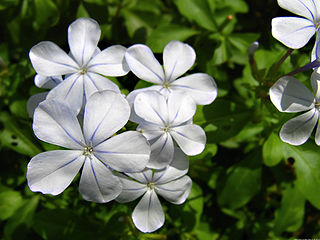
Plumbago is a genus of 23 species of flowering plants in the family Plumbaginaceae, native to warm temperate to tropical regions of the world. Common names include plumbago and leadwort.

Commiphora is the most species-rich genus of flowering plants in the frankincense and myrrh family, Burseraceae. The genus contains approximately 190 species of shrubs and trees, which are distributed throughout the (sub-) tropical regions of Africa, the western Indian Ocean islands, the Arabian Peninsula, India, and South America. The genus is drought-tolerant and common throughout the xerophytic scrub, seasonally dry tropical forests, and woodlands of these regions.
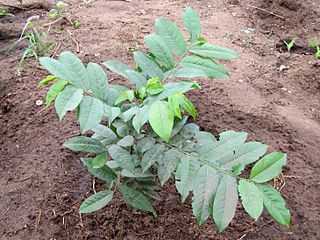
Mkilua is a genus of plant in the family Annonaceae. It is native to Kenya and Tanzania. It contains a single species, Mkilua fragrans. Bernard Verdcourt, the British botanist who first formally described the species, named it after the fragrance of its flowers which smell like lemon. It is commonly called Mkilua Mwitu, Kilua and Kiluwa in Swahili, and Kingade in Digo. Volatile oils extracted from its leaves, flowers, and aerial parts have been reported to be repellent to Anopheles gambiae mosquitoes which are vectors for the malaria parasite Plasmodium falciparum. Bioactive molecules extracted from its roots have been reported to have antimicrobial activity in tests with Streptococcus agalactiae and Staphylococcus aureus.

Ternstroemia is a genus of flowering plants in the family Pentaphylacaceae. It is distributed in tropical and subtropical regions in Africa, Asia, and the Americas.
Warburgia elongata is a species of plant in the family Canellaceae. It is endemic to Tanzania.
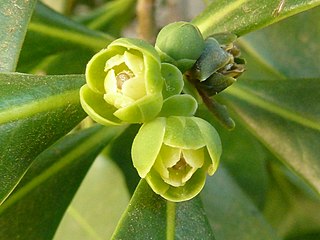
Warburgia salutaris is a species of tree in the family Canellaceae. It is found in eastern and southern African locations e.g. Botswana, Namibia, Kenya, Tanzania, Zambia, Mozambique, South Africa, Eswatini, Malawi and Zimbabwe. It is threatened by habitat loss. It is a popular medicinal plant and is overharvested in the wild, another reason for its endangerment. The Pepper-bark tree is a protected tree in South Africa. Various projects are investigating methods of propagation under controlled conditions with subsequent planting in the wild.
Warburgia stuhlmannii is a species of plant in the family Canellaceae. The genus is named after Dr Otto Warburg, botanist and lecturer in Berlin. and the species after Franz Stuhlmann, also a renowned botanist who directed the Amani Research Institute and its botanical garden in German East Africa. It is a rare, small, evergreen tree, reaching heights from 12 to 24 metres, and has glossy leaves. It is found in the coastal woodlands and forests of Kenya and Tanzania and is threatened by habitat loss. It is known as mkaa in Swahili.

Warburgia ugandensis, also known as Ugandan greenheart or simply greenheart tree, is a species of evergreen tree native to East Africa. Countries in which the plant species is found include Kenya, Tanzania and Uganda. The wood is resistant to insect attack and very strong. It was commonly used for the yoke pole of ox-wagons, the Disselboom. Early Indian immigrants to Kenya, working on the construction of the railway, used the leaves to flavor their curries before the chilli plant was commonly introduced. The flavor is hot and subtly different from chillies.
Mitragyna rubrostipulata is a tree indigenous to East Africa. It is native from Ethiopia through east-central tropical Africa to Mozambique. It grows in wet forests up to 2,000 m above sea level and is abundant in swamp forests along Lake Victoria.
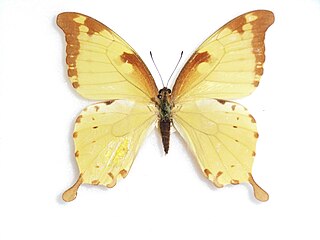
Papilio nobilis, the noble swallowtail, is a butterfly of the family Papilionidae. It is found in Africa.

Agelanthus is a genus of Afrotropical plants in family Loranthaceae. They grow in trees, including Acacia and Combretum species, as hemiparasitic shrubs of varying sizes. The host plant is penetrated by a single haustorium, and the stems typically have swollen, flower-producing nodes. The flowers are often closely clustered (fascicled) with the five petals (pentamerous) fused into a tube (gamopetalous). The flower may have a swollen base and the tubes open along unilateral, V-shaped splits. The filaments remain spirally rolled inward when the flowers open, while the styles are inconspicuous, slender filaments that are somewhat thickened in the middle. Berries range from pink to orange and red in colour, and are around 1 cm in diameter.

Furoquinoline alkaloids are a group of alkaloids with simple structure. Distribution of this group of alkaloids is essentially limited to plant family Rutaceae. The simplest member of this group is dictamnine and most widespread member is skimmianine.
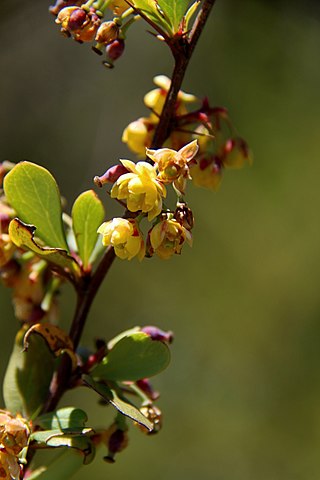
Berberis holstii is a spiny evergreen shrub assigned to the barberry family, with simple leaves, hanging panicles with a few yellow flowers and eventually blackish-blue berries. It is one out of only species of Berberis that grow in the wild in Africa, where it can be found at high altitudes in Tanzania, Uganda, Kenya, Ethiopia, Somalia, and Malawi. It is also reported from Yemen and Oman. In Malawi it is known as Kayunga, while in Ethiopia it is called Gewo, Yeset af in Amharic, as well as Zinkila, a name also used in the Afar language, and Godxantool in the Somali language.
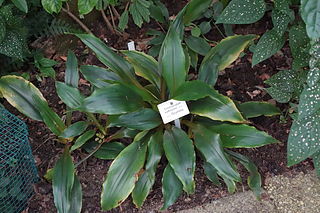
Chlorophytum holstii is a flowering plant species in the genus Chlorophytum, endemic to Tanzania and Kenya.

Croton megalocarpus is a tree species in the family Euphorbiaceae. It is indigenous to ten countries in Sub-Saharan Africa, including Somalia, Kenya, Uganda, Democratic Republic of the Congo, Rwanda, Burundi, Tanzania, Malawi, Zambia, and Mozambique.
Oliverella is a genus of flowering plants belonging to the family Loranthaceae.
Asteranthe asterias is a species of plant in the family Annonaceae. It is native to Kenya and Tanzania. Spencer Le Marchant Moore, the English botanist who first formally described the species using the basionym Uvaria asterias, did not explicitly explain the epithet, but was likely referencing the star-like appearance of its flower’s petals.

Lannea schweinfurthii is a small to medium sized deciduous tree within the Anacardiaceae family. The tree is sometimes called 'bastard marula' or 'false marula' because when it is without flowers or fruits, it become quite similar to the marula tree and sometimes it's confused for the marula tree. Extracts of the species is used in traditional human and veterinary medical practices.















